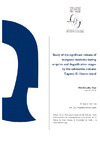Please use this identifier to cite or link to this item:
https://accedacris.ulpgc.es/jspui/handle/10553/74654
| Title: | Study of the significant release of inorganic nutrients during eruptive and degasification stages by the submarine volcano Tagoro, El Hierro island | Authors: | González Vega, Alba | Director: | Santana Casiano, Juana Magdalena Fraile Nuez, Eugenio |
UNESCO Clasification: | 251002 Oceanografía química | Keywords: | Volcano Tagoro (El Hierro Island) Inorganic nutrients |
Issue Date: | 2018 | Project: | "Volcanic Eruption At El Hierro Island, Sensitivity And Recovery Of The Marine Ecosystem" BIMBACHE (IEO-2011-2012) RAPROCAN-III (IEO-2011-2013) |
Abstract: | On October 10th 2011 a shallow submarine volcanic eruption south of El Hierro (Canary Islands) gave rise to a drastic physical-chemical change in the water column. The initial eruptive phase affected a wide area south of the island, along with a plume that was observed to be transported north-westwards during November 2011. From March 2012 the volcanic activity shifted towards a degasification stage, during which the emissions affected a smaller area surrounding Tagoro submarine volcano and quite close to the seabed. Periodic multidisciplinary oceanographic cruises were carried out in order to monitor the impacts of these emissions. Discrete water samples were collected for analysis of inorganic macronutrients (NO2 - +NO3 -, PO4 3-, and SiO4 4-). Here, we present the spatial and temporal distribution of these nutrients from November 2011 to March 2014 with the data of 9 different cruises and more than 2450 samples in the area affected by the volcano. Our results highlight the significant nutrient emissions for both the eruptive / degasification stages, with maximum concentrations of 8.14 / 6.20, 0.78 / 0.29 and 21.63 / 18.56 μmol kg-1 of nitrite+nitrate, phosphate and silicate, respectively. Comparing the mean concentrations of the emissions with reference values, remarkably large percentages of nutrient enrichments have been obtained, quantified as 152% / 136%, 1118% / 377% and 2002% / 1534%, respectively. Furthermore, in the area affected by the volcano, N:P ratios of 4.28 for the eruptive and 12.36 for the degasification phase have been obtained, lower than the approximately 16:1 Redfield ratio that characterized the reference stations. Similarly, N:Si ratios found were 0.25 and 0.22 (reference: 3.40), and P:Si ratios were 0.02 and 0.01 (reference: 0.12), highlighting the large proportion in which silicate was emitted respect to the other nutrients. Finally, significant positive concentrations of chlorophyll-a respect to the reference were observed with data from several yo-yo and tow-yo studies, suggesting the possibility of a natural fertilization process that could have an important impact on the marine ecosystem surrounding Tagoro submarine volcano. | Department: | Departamento de Química | Faculty: | Facultad de Ciencias del Mar | Degree: | Máster Universitario en Oceanografía por la Universidad de Cádiz, la Universidad de Las Palmas de Gran Canaria y la Universidad de Vigo | URI: | https://accedacris.ulpgc.es/handle/10553/74654 |
| Appears in Collections: | Trabajo final de máster |
En el caso de que no encuentre el documento puede ser debido a que el centro o las/os autoras/es no autorizan su publicación. Si tiene verdadero interés en el contenido del mismo, puede dirigirse al director/a o directores/as del trabajo cuyos datos encontrará más arriba.
Show full item recordPage view(s)
127
checked on Jul 20, 2024
Download(s)
25
checked on Jul 20, 2024
Google ScholarTM
Check
Share
Export metadata
Items in accedaCRIS are protected by copyright, with all rights reserved, unless otherwise indicated.
